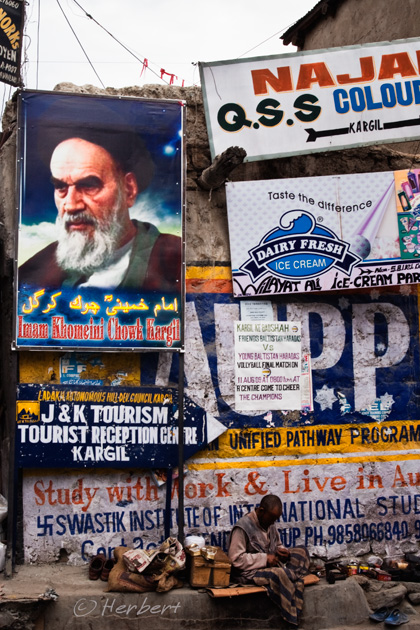August 31, 2009
August 30, 2009
Iran's influence is felt everywhere in Kargil, India
Location: Khomeini Chowk, Kargil, Kashmir, India (34° 34′ 12″ N, 76° 6′ 0″ E)
Date: 16 August 2009 4.35pm
Camera: Canon 400D with Sigma 17-70/f2.8-4.5
Muslims make up less than 15% of India's population; however, it is still a sizeable at least 154 million, making it the country with the 3rd largest Muslim population in the world (after Indonesia and Pakistan). The majority (about two-thirds) of India's Muslims are Sunnis. Shiites are prominent in certain parts such as Agra and Kargil. The latter is well-known as the epicentre of the Fourth Indo-Pakistan War in 1999, dubbed the Kargil War. In Kargil, Shiites are the majority and as such, one can see the influence of Iran everywhere as Iran has the biggest Shiites population in the world. Iran's influence is so prevalent that there are posters of its leaders in many places- even a street in the Main Bazaar is named after the founder of the Islamic Republic of Iran- Khomeini Chowk.
August 27, 2009
Yamdroktso and Mount Nojin Kangtsang, Tibet, China
 Location: Yamdrok Tso, Tibet, China, (28° 56′ 0″ N, 90° 41′ 0″ E)
Location: Yamdrok Tso, Tibet, China, (28° 56′ 0″ N, 90° 41′ 0″ E)
Date: 23 April 2003; 10.05am
Camera: Canon G1
Yamdroktso is one of the four most sacred lakes to the Tibetans. The lake is shape like a fan and is surrounded by numerous snow peaks, including Nojin Kangtsang (7,252m) as seen here. It is one of the most beautiful lakes in Tibet with clear turquoise waters. However, the beauty of the lake is likely to be irrevocably damaged by both the building of a hydroelectric plant at the site as well as gold exploration activities in its immediate vicinity. The scarring was already visible back in 2003 with land clearing activities along its shores. I cannot imagine what damage had been done to its beauty by now.
August 25, 2009
India- as it always was
 Location: Central Post Office, Srinagar, Jammu & Kashmir, India (34° 4' 60 N, 74° 49' 0 E)
Location: Central Post Office, Srinagar, Jammu & Kashmir, India (34° 4' 60 N, 74° 49' 0 E)
Date: 18 August 2009 11.35am
Camera: Canon Ixus IZoom
India always amazes me in many ways. One of the most amazing things is how nothing ever- and I mean, really ever- change in this country. These post-boxes are really ancient- I suspect these are the same design and look when the country was under British colonization (India had been independent since 1947). The other amazing fact that this post-boxes illustrate is the confusion or perhaps more accurately, the ironic in the country's own existence as an independent sovereign nation. The country had struggled for over 200 years to rid itself from the yolk of suppression and humiliation of British colonization but yet it still cling on to all that is British- the symbol of the British Raj. One example is the short 3-foot bamboo stick, the lathi that most Indian policemen carry. I always remember seeing British officials in Bollywood movies of the colonial era customarily carrying one and using them on the locals. More comically, senior Indian police officers today also carry one of those short stick that were introduced and used by their British colonial counterparts.
More posts on India on the way
I have just returned from a couple of weeks travelling in Northern India. I have travelled in India on about a dozen ocassions. Naturally I have some observations, likes and feelings about the place, the people, politics, society and system. I will be writing a few more posts in the next few weeks on India while my thoughts are still fresh.
August 17, 2009
Away Travelling Again
I have been travelling again in Northern India for the last couple of weeks. Will be posting more photos and stories when I get back soon.
August 3, 2009
Calm waters of a tiburtary of Muar River
Location: Muar River near Parit Jawa, Johor, Malaysia (1° 57′ 0″ N, 102° 39′ 0″ E)
Date: 17 April 2004 3.40pm
Camera: Canon G1
Parit Jawa is a little fishing village in Johor beside the Muar River. It has a mudflat that is the feeding ground for a flock of Lesser Adjutants plus many other birds that feed in the mudflat and mangrove ecosystem. It is also a tranquil village with lazy fishing boats along the river banks. However all this may be changing as there are plans to develop the area around here. There doesn't seem to be any study or consideration of the developments on the ecosystem.
August 2, 2009
Kashgar's historical Old Quarters gone forever
Location: Kashgar Old Quarters, Xinjiang, China (39° 45' 26 N 78° 24' 18 E)
Date: 7 August 2007; 2.20pm
Camera: Canon 400D with Sigma 17-70/f2.8-4.5
Xinjiang, like Tibet, is starting to become a headache for the Chinese government. It is sometimes quite unbelievable that the Chinese government is not aware of the problems, resentment and antagonism that their policies are causing to the original inhabitants of these "provinces". The undercurrents were just bubbling below the surfaces everywhere when one bothers to talk to the ethnic minorities in these places. To add salt to wounds in Xinjiang, the Chinese government had demolished the historical and ancient Old Quarters of the ancient oasis town of Kashgar. In fact before the demolition, this maze of mud-houses had already became something of a circus with the government licensing a Han company to seal off parts of the old quarters to tourists; entrance only by paying a fee. Even an idiot would have realised that such action is bound to create resentment among the dwellers.




















